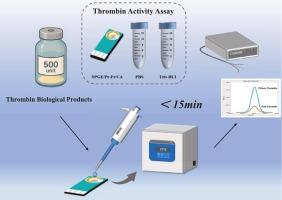Facile electrochemical assay of thrombin activity in biological products
IF 4.1
3区 化学
Q1 CHEMISTRY, ANALYTICAL
引用次数: 0
Abstract
Thrombin, a critical protein-based therapeutic agent, is widely used in modern medicine. Precise quantification of thrombin enzymatic activity represents a fundamental requirement for both manufacturing quality control and clinical therapeutic monitoring. Here, we developed a “signal-off” electrochemical method for the rapid detection of thrombin activity within 15 min. A thrombin-specific substrate peptide was anchored to a gold electrode via Au![]() S bonds at its C-terminal, with an N-terminal ferrocene (Fc) tag as a redox probe. A cellulose acetate (CA) membrane was added to reduce contamination and signal loss. The detection mechanism relies on thrombin-mediated peptide cleavage, detaching the Fc-tagged fragment and generates a decreasing current proportionally to enzyme activity. The detection limit of the described method is 81.1 U/mL, with a linear response over the range of 200–1500 U/mL (R2 = 0.9941), satisfying the quality control requirements for commercial thrombin drugs. This biosensing strategy combines operational simplicity with analytical reliability, showing significant potential for rapid and efficient assessment of thrombin biological products activity.
S bonds at its C-terminal, with an N-terminal ferrocene (Fc) tag as a redox probe. A cellulose acetate (CA) membrane was added to reduce contamination and signal loss. The detection mechanism relies on thrombin-mediated peptide cleavage, detaching the Fc-tagged fragment and generates a decreasing current proportionally to enzyme activity. The detection limit of the described method is 81.1 U/mL, with a linear response over the range of 200–1500 U/mL (R2 = 0.9941), satisfying the quality control requirements for commercial thrombin drugs. This biosensing strategy combines operational simplicity with analytical reliability, showing significant potential for rapid and efficient assessment of thrombin biological products activity.

生物制品中凝血酶活性的简易电化学测定
凝血酶是一种重要的蛋白质治疗药物,在现代医学中有着广泛的应用。凝血酶酶活性的精确定量是生产质量控制和临床治疗监测的基本要求。在这里,我们开发了一种“信号关闭”电化学方法,用于在15分钟内快速检测凝血酶活性。一种凝血酶特异性底物肽通过c端AuS键固定在金电极上,n端二茂铁(Fc)标签作为氧化还原探针。添加醋酸纤维素(CA)膜以减少污染和信号损失。检测机制依赖于凝血酶介导的肽切割,分离fc标记的片段,并产生与酶活性成比例的递减电流。方法的检出限为81.1 U/mL,在200 ~ 1500 U/mL范围内具有良好的线性响应(R2 = 0.9941),满足市售凝血酶药物的质量控制要求。这种生物传感策略结合了操作简单性和分析可靠性,显示出快速有效地评估凝血酶生物制品活性的巨大潜力。
本文章由计算机程序翻译,如有差异,请以英文原文为准。
求助全文
约1分钟内获得全文
求助全文
来源期刊
CiteScore
7.80
自引率
6.70%
发文量
912
审稿时长
2.4 months
期刊介绍:
The Journal of Electroanalytical Chemistry is the foremost international journal devoted to the interdisciplinary subject of electrochemistry in all its aspects, theoretical as well as applied.
Electrochemistry is a wide ranging area that is in a state of continuous evolution. Rather than compiling a long list of topics covered by the Journal, the editors would like to draw particular attention to the key issues of novelty, topicality and quality. Papers should present new and interesting electrochemical science in a way that is accessible to the reader. The presentation and discussion should be at a level that is consistent with the international status of the Journal. Reports describing the application of well-established techniques to problems that are essentially technical will not be accepted. Similarly, papers that report observations but fail to provide adequate interpretation will be rejected by the Editors. Papers dealing with technical electrochemistry should be submitted to other specialist journals unless the authors can show that their work provides substantially new insights into electrochemical processes.

 求助内容:
求助内容: 应助结果提醒方式:
应助结果提醒方式:


